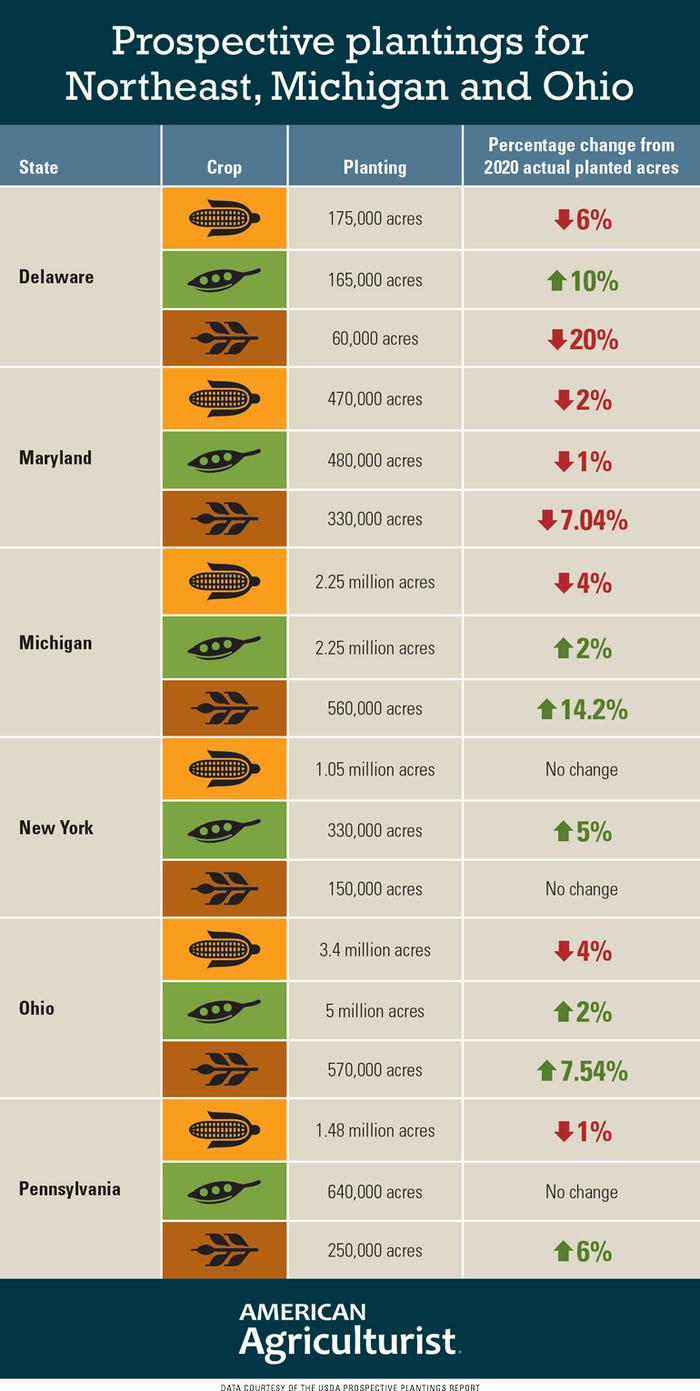
If you’re a cash crop producer, 2021 is shaping up to be a great year. If you’re a livestock producer, challenges await.
That’s the general sentiment from analysts based on USDA’s Prospective Planting Report for 2021. Farmers are expected to plant 91.1 million acres of corn, up less than 1% from last year; 87.6 million acres of soybeans, up 5% from last year; and 46.4 million acres of wheat, also up 5% — but the fourth-lowest since records began in 1919.
So, what are farmers in the Northeast, Michigan and Ohio thinking? More soybeans are going into the ground this spring, as well as higher wheat production in most places, too, largely mirroring the national trend of more soybean and wheat acres, and a smaller increase in corn acres. The actual planted acreage will be adjusted as the season moves forward.
Take a look at the graphic below to see projected acreage of corn, soybeans and wheat across the highest production states in the region.

Other states in alphabetical order:
Corn
Connecticut. 26,000 acres, up 8.3%
Maine. 27,000 acres, down 10%
Massachusetts. 14,000 acres, unchanged
New Hampshire. 13,000 acres, unchanged
New Jersey. 85,000 acres, down 2.2%
Vermont. 81,000 acres, down 4.7%
West Virginia. 53,000 acres, up 3.9%
Soybeans
New Jersey. 105,000 acres, up 11%
Hay
Pennsylvania has the most hay acres at 1.35 million acres, down slightly from last year.
New York’s hay acreage is 1.08 million acres, up 1.8%. Ohio hay acreage is 880,000 acres, up 2.3%. Michigan hay acreage is 820,000 acres, up 5.12%.
Other states:
Connecticut. 45,000 acres, down 2.2%
Delaware. 14,000 acres, no change
Maine. 104,000 acres, no change
Maryland. 210,000 acres, up 5%
Massachusetts. 68,000 acres, up 13%
New Hampshire. 50,000 acres, up 19%
New Jersey. 110,000 acres, up 3.77%
Vermont. 165,000 acres, down 1.19%
West Virginia. 575,000 acres, up 6.4%
Barley
Delaware. 21,000 acres, no change
Maine. 15,000 acres, no change
Maryland. 35,000 acres, up 2.9%
Michigan. 15,000 acres, up 36%
New York. 9,000 acres, no change
Pennsylvania. 39,000 acres, down 13.3%
Oats
Maine. 23,000 acres, down 11%
Michigan. 75,000 acres, up 7.42%
New York. 47,000 acres, down 9.61%
Ohio. 65,000 acres, up 18%
Pennsylvania. 65,000 acres, down 24%
Winter wheat
New Jersey. 23,000 acres, down 8%
About the Author(s)
You May Also Like






